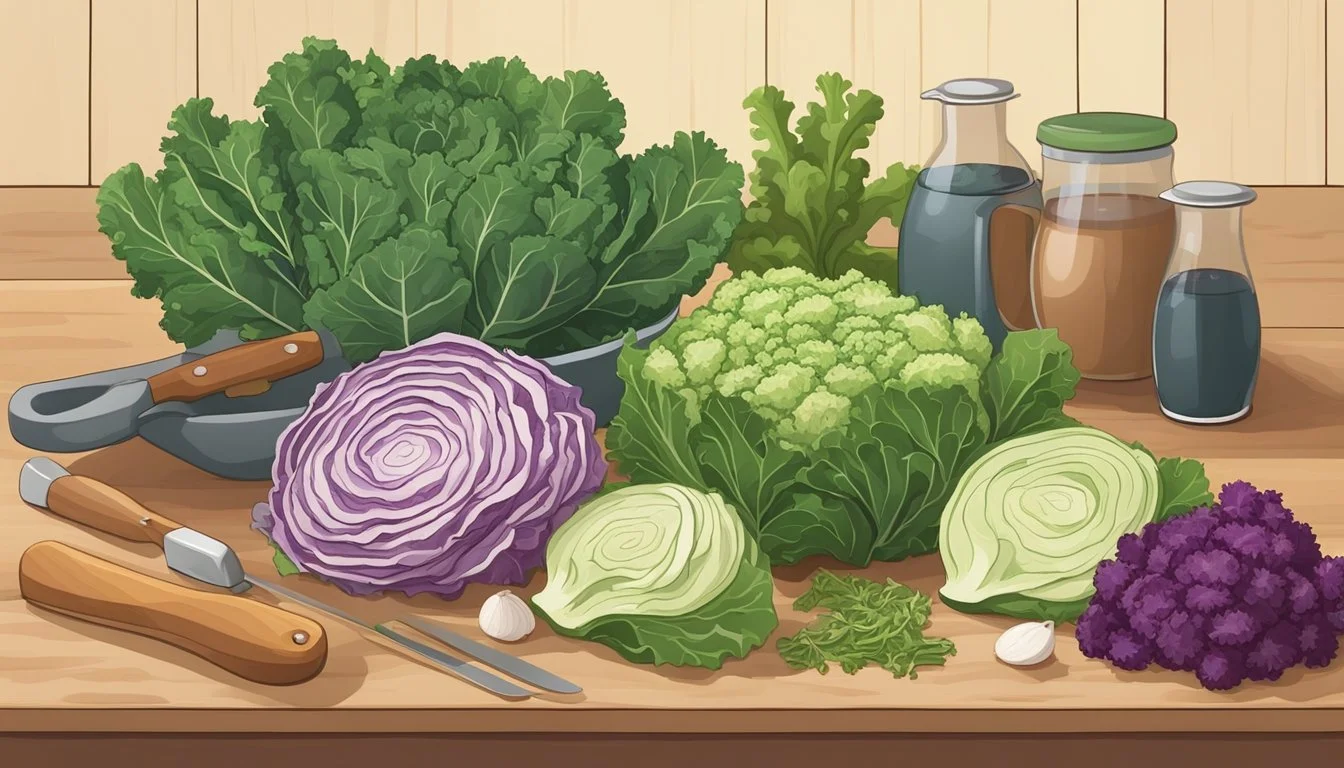Ornamental Kale Substitutes
Best Alternatives for Your Garden
Ornamental kale, with its vibrant hues and frilly leaves, serves more as a decorative plant than an edible green. Whether it’s adding a splash of color to a garden or serving as a garnish, its firm texture and unique appearance make it a popular choice for various aesthetic purposes. When it comes to cooking, ornamental kale isn't typically suitable, prompting the need for viable substitutes.
Collard greens make an excellent substitute for ornamental kale, both nutritionally and in texture. Sharing the same cabbage family, collard greens have dark, hearty leaves that can withstand similar cooking methods. Similarly, mustard greens present an alternative with a slightly spicy flavor, offering a zestier option for dishes that originally called for ornamental kale.
Spinach, particularly baby spinach, can also replace ornamental kale in many recipes due to its tender texture and mild taste. Though different in appearance, spinach can add variety to your meals while maintaining a healthy diet. Remember to choose the substitute that best fits the culinary context, ensuring taste and texture align with your intended dish.
Understanding Ornamental Kale
Ornamental kale is a versatile and aesthetically pleasing leafy green primarily grown for its decorative appeal. It shares many characteristics and health benefits with edible kale but is often distinguished by its vibrant colors and unique texture.
Characteristics of Ornamental Kale
Ornamental kale belongs to the Brassica family, similar to its edible cousins like broccoli, cabbage, and mustard greens. It is renowned for its curly, frilly, or feathered leaves which come in various shades of purple, pink, white, and green.
The leaves are typically thick and leathery, giving it a bold texture that stands out in gardens and decorative displays. When matured, ornamental kale plants reach sizes ranging from 12 to 18 inches in both height and width.
Nutritional Profile of Ornamental Kale
Ornamental kale, although primarily grown for decoration, shares a rich nutritional profile with edible kale. It is packed with vitamins C and K, which are vital for immune function and bone health. Additionally, it contains essential minerals such as calcium, potassium, and magnesium, contributing to overall well-being.
The leafy green is also high in antioxidants, which help fight oxidative stress and support overall health. While it can be consumed, it's crucial to note that ornamental varieties may have a slightly different taste and texture than traditional kale.
Culinary Uses of Ornamental Kale
Though mainly ornamental, this type of kale can also be used in culinary applications. When used, it is typically as a garnish due to its striking appearance and somewhat bitter flavor. The leaves can be eaten raw in salads or lightly cooked to soften their texture.
However, care should be taken to ensure that the ornamental kale has been grown without ornamental pesticides or chemicals if considering consumption. Its strong, earthy flavor and firm texture make it a unique addition to dishes, although it may not be as tender or sweet as other culinary kale varieties.
These sections provide important information on ornamental kale, offering insights into its characteristics, nutritional benefits, and culinary uses.
Ornamental Kale Substitutes Overview
When looking for substitutes for ornamental kale, choose options that meet specific criteria for visual appeal and culinary use. Consider both flavor and texture to ensure the alternatives provide a similar or complementary experience.
Criteria for Choosing Substitutes
Ornamental kale is valued for its vibrant colors and firm texture. Key criteria for selecting its substitutes include:
Visual Appeal: The substitute should have bright, attractive colors. Options include plants with similar greens, purples, or variegated leaves.
Texture: It should offer a firm, robust texture to match or enhance the visual quality.
Availability: The substitute should be readily found in local grocery stores or markets.
Palatability: The flavor should be pleasant, whether used raw or cooked.
Substitutes Comparison
Collard Greens: Similar in texture and part of the same cabbage family. They have dark green leaves and a sturdy structure.
Swiss Chard: Adds color variety with its bright stems. The leaves are tender yet firm, making it visually appealing.
Mustard Greens: Offers a slightly spicier flavor with a similar texture. Available in various colors, including purple and green.
Spinach: While less firm, it provides a mild flavor and can be a good choice for some culinary applications.
Substitute Visual Appeal Texture Flavor Availability Collard Greens Dark Green Firm Mildly Bitter High Swiss Chard Bright Stems Tender Yet Firm Slightly Earthy High Mustard Greens Varied Colors Robust Spicy Moderate Spinach Dark Green Tender Mild High
These substitutes ensure your dishes remain visually appealing while providing comparable flavors and textures.
Common Substitutes for Ornamental Kale
If you’re looking for alternatives to ornamental kale, there are several nutrient-rich and flavorful options. Some excellent choices include collard greens, spinach, Swiss chard, arugula, mustard greens, and various types of lettuce.
Collard Greens as a Substitute
Collard greens are a strong contender. They belong to the same cabbage family as kale and share a similar texture and taste. These dark, leafy greens can be used in salads, soups, and stir-fries. Their hearty leaves make them an ideal substitute in recipes that call for the robust texture of ornamental kale.
Spinach: A Versatile Option
Spinach is a versatile choice. Its tender leaves are more delicate compared to ornamental kale, but it works well in any dish where a lighter texture is desired. Baby spinach can enhance raw dishes like salads or smoothies, while mature spinach holds up well in cooked recipes such as quiches and sautés.
Swiss Chard: Colorful Alternative
Swiss chard is known for its vibrant colors. With green leaves and colorful stems that range from red to yellow, it not only adds nutrition but also aesthetic appeal to meals. Its taste is earthy and slightly bitter. Swiss chard can substitute for ornamental kale in gratins, casseroles, and savory pies.
Arugula: Adding a Peppery Flavor
Arugula offers a distinct peppery flavor. It can add a spicy kick to dishes where ornamental kale might have been used. Suitable for salads, sandwiches, and as a pizza topping, arugula's small, tender leaves are best used fresh. Their unique taste can liven up cooked dishes if added just before serving.
Mustard Greens: Bold and Bitter
Mustard greens bring a bold and bitter taste. They boast a stronger flavor than ornamental kale, making them perfect for those who enjoy a bit of bite in their greens. Often utilized in Southern cuisine, mustard greens work well in braises, stir-fries, and as a garnish for roasted meats or hearty soups.
Romaine and Iceberg Lettuce
Romaine and iceberg lettuce are milder options. Though they lack the robust flavor of ornamental kale, these lettuces provide a crisp texture that can be refreshing in salads or as a base for various dishes. Romaine offers more nutrients, while iceberg is known for its water content and crunchiness.
These substitutes not only offer similar textures and flavors but also diversify the nutrient profile and visual appeal of your dishes.
Leafy Green Substitutes in Specific Dishes
Choosing the right leafy green for your dishes can elevate the flavor and texture. This guide will help you swap out kale in salads, smoothies, soups, stews, and sandwiches with ease.
Best Substitutes for Salads
Arugula is a fantastic substitute in salads. Its peppery taste adds a punch to any dish. Chop it finely for a kale salad or mix it in slaws.
Romaine lettuce is another good choice, providing a milder flavor. However, you may need extra seasoning to match the robust taste of kale.
Spinach works well due to its tender leaves and slight sweetness. It can be used raw or lightly wilted.
Ideal Greens for Smoothies
Spinach is an excellent alternative for smoothies. It blends smoothly and boasts a mild flavor that doesn't overpower other ingredients.
Swiss chard, especially the green variety, adds a nice color and nutrient boost. Remove the stems for a smoother texture.
Collard greens can also be used, though they have a firmer texture. They bring a slightly bitter taste that pairs well with sweet fruits.
Leafy Greens for Soups and Stews
Collard greens are perfect for hearty dishes like soups and stews. They retain their texture and add a rich, slightly bitter flavor.
Swiss chard works well, providing a similar texture to kale. It adds color and nutrients, especially in brothy soups and stews.
Mustard greens can also be used, imparting a spicy kick that enhances the overall flavor of your dish.
Alternatives for Sandwiches and Wraps
Romaine lettuce is a great substitute in sandwiches and wraps, offering crunch and a neutral flavor.
Arugula can add a peppery note to your wraps, making them more interesting.
Spinach is versatile and fits well in both sandwiches and wraps, providing a mild taste and a soft texture.
Using these substitutes can keep your meals exciting and nutritious while seamlessly replacing kale.
Other Kale Substitute Considerations
When considering alternatives to ornamental kale, it's critical to look at nutritional content, how different options pair with flavors, and their availability throughout the year.
Substitutes Based on Nutritional Content
Nutrient-dense options like collard greens and spinach provide beneficial vitamins and minerals. Collard greens, with high levels of calcium, iron, and folic acid, serve as robust substitutes. Spinach offers a softer texture and is rich in vitamin C, potassium, and manganese.
Arugula is another nutrient-rich option, contributing vitamin C and calcium. It may not be as hearty but offers a zesty flavor. Choosing substitutes with similar nutrient profiles ensures that dietary benefits are maintained.
Flavor Pairings and Combinations
The taste profile of substitutes is essential in maintaining the desired flavor of a dish.
Mustard greens offer a spicy note, adding complexity when raw or cooked. Romaine lettuce and iceberg lettuce provide milder flavors, which might require additional seasonings. Both are ideal for salads and sandwiches.
Collard greens align more closely with kale in terms of bitterness and texture, making them suitable for soups and stews. Experimentation with herbs and spices can enhance the flavors of these substitutes.
Availability and Seasonality of Substitutes
Freshness and ease of access are important for leafy greens. Romaine lettuce and iceberg lettuce are widely available year-round, making them convenient options.
Collard greens and mustard greens might be seasonal in some regions, typically more available in cooler months. Arugula can be found in many grocery stores but may be subject to availability depending on local agricultural cycles.
Understanding local growing seasons and market availability ensures optimal quality and freshness when selecting substitutes.
Preparation Tips for Kale Substitutes
Proper storage and enhancing flavor and texture are crucial when preparing substitutes for ornamental kale. This ensures the greens remain fresh and the dishes are flavorsome.
How to Store Leafy Greens
To keep leafy greens fresh, proper storage is essential. Whether it's romaine lettuce, Savoy cabbage, or arugula, rinse thoroughly before storing. Shake off excess water and wrap loosely in a paper towel.
Place them in a resealable plastic bag with small air holes. Store them in the refrigerator's crisper drawer. Bok choy can be stored similarly but ensure the base is slightly wet to retain its crunch. For mustard greens, ensure they are dry before refrigerating to maintain their texture.
Ways to Enhance Flavor and Texture
Enhancing the flavor and texture of kale substitutes requires attention to detail. For leafy greens, massaging with a bit of olive oil and a pinch of salt can soften their texture and bring out flavors, particularly for kale substitutes like arugula and mustard greens.
Sautéing with garlic and a splash of lemon juice can add zest and aroma. For a crunchy texture, try roasting or grilling bok choy or Savoy cabbage. Seasonings like soy sauce, sesame oil, or balsamic vinegar can elevate dishes, achieving a balance between flavor and texture.








